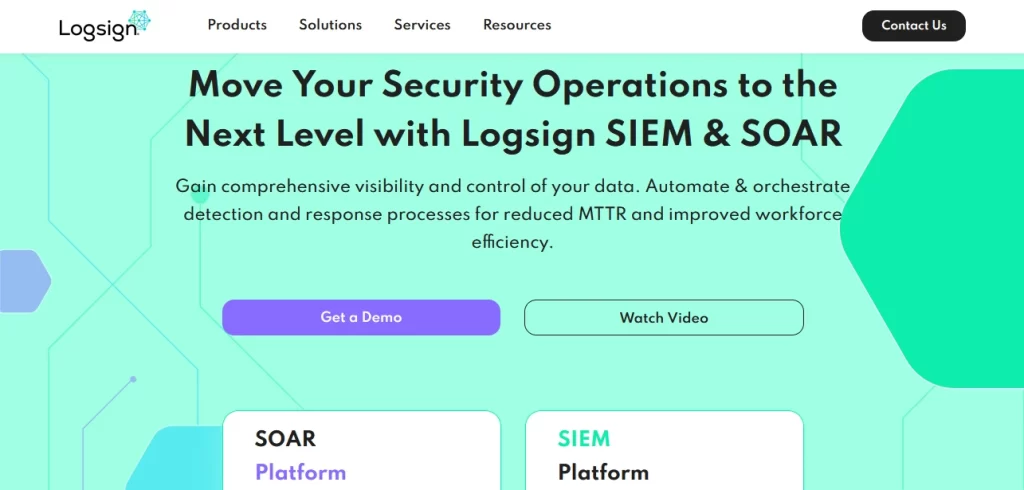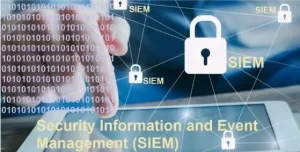Introduction
Organizations have many critical assets that demand just enough security protection and safeguards. Securing these valuable assets enables businesses to go a long way in building reputation and trust by their customers. Besides, establishing dependable security posture enables organizations to minimize risk to an acceptable level. And this in turn will boast and enhance productivity to finally achieve their business goals and objectives. Further, there are various security mechanisms to help organizations realize their business requirements and strategic goals, mission and vision.
Most businesses assume that they are secure by default as long as they have state-of-the-art security controls in place. However, this big misconception and false confidence have the potential of causing existential threat and damage to their businesses. Instead, businesses should always employ ‘assumption of breach’ principle when it comes to securing their important assets. Besides, they should practice due care and due diligence in the entire organizational structure. Furthermore, good security starts at the top, mostly at the governance and management level, and employs defense-in-depth approach.
Security threats differ from one organization to another. Therefore, organizations should develop robust security strategies and programs that align with their business objectives. Moreover, there is no one-size-fits-all strategy when it comes to dealing with organizational security risks and threat landscape. Additionally, each organizations should pay close attention to indicators of compromise (IoC), threat intelligence feeds and dependable security reports, such as MITRE ATT&CK.
There are tons of security controls to select from and protect your valuable assets in particular and business in general. SIEM tools are one of the best security controls that you can employ to protect your businesses. In this blog post, we will walk you through some of the top SIEM tools that you can consider to safeguard your organization.
What is a SIEM Solution?
Before deep diving into the SIEM tools, let us first have a brief overview about Security Information and Event Management famously known as SIEM solution. SIEM is a security control that collects data from various sources and analyzes it for possible security events and incidents. And it supports security threat detection and security incident response through a real-time collection and analysis of each event /incident. Moreover, SEIM solution is the most effective and efficient way to determine aggregate risk from different sources in your organizations. And it is the best countermeasure against Advanced Persistent Threats (APTs). Furthermore, it performs granular assessments and scrutiny to detect cyberattacks based on their signature or behavioral analysis.
SIEM solution is a security platform that ingests security event logs from various contextual data sources. And it provides a single and unified view of this data with further insights of data –driven decision making.
The major capabilities of most SIEM solutions include the following:
Types of SIEM Solutions
- Log collection, analysis, processing, and management
- Searching and reporting on security events and incidents of normalized/raw data
- Real-time security monitoring to detect indicators of compromise (IoC) or indicators of attack (IoA) through event/incident response system, event correlation engine and advanced analytics
- End to end security incident management and automated workflows to deal with the incidents
- Integration with reliable sources of threat intelligence and threat feeds from open source intelligence (OSINT) and third-party security providers
- Advanced security threat detection features
- Provide user and entity behavior analytics (UEBA) based on acceptable use policy (AUP), organizational security policies and other compliance requirements
- Generating auditing reports and compliance templates
Organizations nowadays have the freedom to choose the architecture of their SIEM solution. Meaning, they can acquire it as an appliance/software on-premise or SaaS from the cloud environments.
Types of SIEM Solutions
There are mainly three types of SIEM solutions, namely:
- On-premise SIEM
- Cloud SIEM
- Managed SIEM
How does a SIEM work?
In order to establish reliable SIEM solution, you have to export logs and event data from the entire IT infrastructure and systems. And then you should feed it into the SIEM platform through SIEM agents. Moreover, SIEM agents are programs that you deploy and run on various systems and endpoints that analyze and export data into the centralized platform. Furthermore, SIEM tools aggregates log data, security alerts, and events/ incidents into a centralized platform to provide real-time analysis for security monitoring.
In order to get better protection, organizations should integrate the SIEM software with their SOC platform. Moreover, Security Operation Center (SOC) helps you to display security alerts and incidents it receives from other security controls. Besides, SIEM is the foundation for the SOC of your organization.
SIEM software mainly works by collecting log and event data that devices, applications, networks, systems and infrastructures produce. Further, it enables you to have complete visibility across these all components to perform detection and analysis of potential security threats.
Some of the characteristics of an effective SIEM solution include the following:
- Correlate and consolidate inputs from different IT systems and infrastructures
- Identify security incidents proactively
- Notify security professionals and analysts
- Prioritize security incidents based on their potential impact
- Monitor and track the status of each security incident
- Integration with other cybersecurity controls and products
- Custom dashboards and alert workflows management
- Provide information on adherence to local and federal policy compliance requirements
Log management systems (LMS), security information management (SIM) and security event management (SEM) are some legacy subsystems of SIEM solutions.
Depending on organizational needs, you can deploy SIEM software either on-premise or cloud environments.
What are the Core Processes of SIEM Solution?
SIEM solutions gather immense amounts of data from your entire IT components, consolidates and makes it human accessible. Moreover, it is a platform for managing security incidents in an organization. Moreover, SIEM solutions employ the following major processes:
Collect data from various sources à Normalize and aggregate the data à Analyze the data to discover and detect security threats à Identify security breaches and enable organizations to further investigate alerts.
The core features of modern SIEM solutions include the following:
- Advanced security threat detection
- Security event and incident detection
- Basic security monitoring
- Forensics and incident response
- Centralized log collection and aggregation
- Normalization
- Notifications and alerts
- Threat response procedures and workflows
What are SIEM Tools?
SIEM tools are software solutions that centralize, aggregate and analyses security events from various sources across your entire information systems. Moreover, SIEM tools perform security event correlation of log entries to combine information from multiple data sources. And from these large log entries, they attempt to identify potential security incidents proactively and provide actionable intelligence. Furthermore, SIEM tools are one of the important security controls to mature your security operations. In addition, SIEM tools collect and aggregate log and event data to help you in identifying and tracking security breaches.
Choosing the right SIEM tool is an important milestone in the security of your organizational assets or businesses. Moreover you should consider many factors such as skillsets, resource constraints, and risk exposure before settling for a SIEM solution. Furthermore, there are many so many options of SIEM tools or software in the market. And organizations should pick the tool that best meets their security and compliance requirements. You have to look for one or more of the following capabilities when selecting the right SIEM tool and solution:
- Horizontal and vertical scalability
- Log data management and compatibility with logs from your firewalls, IDS/IPS solutions, and endpoint systems such as switches, routers, workstations, servers, applications, and cloud environments
- Ability to use predefined/pre-bundled services and customization of the same with minimal effort and time
- Overall security orchestration and workflows automation features such as incident response and management processes
- Capability to provide predictive intelligence using machine learning algorithms and advanced analytics
- Ability to reduce false-positive alerts by developing business use-cases/scenarios
- Time to respond to security events and incidents
What are the Benefits of SIEM Tools?
SIEM solution helps security teams through real-time collection and analysis of huge volume of log data. However, security teams would face tremendous challenge to deal with the security incidents without automated security solutions likewise SIEM. Because, the threat landscape is continuously changing and evolving in complexity, uncertainty and sophistication. Besides, SIEM tools alone cannot handle the security threats and deliver optimal security to an organization. Thus, organizations should integrate them with other security controls in a layered architecture to get better protection. Even so, organizations get many benefits by deploying SIEM solution in their enterprise networks and systems.
Some benefits of SIEM tools or software may include one or more of the following:
- Advanced real-time security threat recognition
- Valuable tool for security and IT operations
- Monitoring users and applications
- Supports security threat detection, compliance, and security incident management in an organization
- Artificial intelligence (AI) driven automation
- Preventing possible security threats from becoming large-scale security incident in a given organization
- Increased efficiency of security professionals and analysts and thereby better utilization of resources
- Reducing security expenditure for an enterprise
- Providing better reporting, compliance, log analysis and data retention services in an organization
- Reducing the impact of security breaches and incidents
- Detecting Advanced and Unknown Threats such as phishing attacks, insider threats, DoS/DDoS attacks, and SQL injection attacks
- Conducting forensic investigations
- Integration with security controls and IT solutions
- Supports compliance adherence, enforcement, auditing and reporting
- Improved organizational efficiency
What are the Limitation of SIEM Tools?
- SIEM tools detects and analyze security events and incidents but do not stop it
- Degrade the performance of systems or networks due to the huge volume of transactional data that traverse the central server and the endpoints
- SIEM software requires high-quality data for maximum result and are only as capable as the data they receive
- Require experienced personnel to implement, maintain and fine-tune it
- SIEM technologies in general are resource intensive solutions
- Provide limited contextual information about their native events and incidents
- Unstructured data and emails protection limitations
- Difficulty in diagnosis and researching security events and incidents
- False positive and false negatives
The core set of functionalities for a SIEM software includes data collection, parsing or normalizing data, and correlating that data to identify suspicious activities. Besides, the core features of most SIEM tools include log management, real-time monitoring and incident investigation. Furthermore, SIEM tools correlate log and event data from all data sources and identifies patterns of compromise to alert the security staff about the suspicious activity.
The following are the top 13 best SIEM tools to watch out in 2023.
1. AT&T Cybersecurity AlienVault Unified Security Management
AlienVault Unified Security Management (USM) is SIEM solution that collects data from different sources, normalizes it, generates alerts and correlate log and event data to take further security measures. Moreover, it centralizes all the security capabilities you need and simplifies your incident response procedures.
AlienVault USM provides graphical alarm dashboard and utilizes Kill Chain Taxonomy to focus on the most severe security threats. In addition, it breaks cyberattacks into five security threat categories namely, system compromise, exploitation and installation, delivery and attack, reconnaissance and probing, and environmental awareness.
Key Features
- Log management
- Event Management and correlation
- Reporting
- Asset discovery
- Network and host Intrusion Detection System (IDS)
- File integrity monitoring
- Cloud Monitoring (AWS, Azure, Office 365, G Suite)
- Incident Response (AlienApps) with 3rd-party security & operations tools
- Vulnerability Assessment
- Continuous Threat Intelligence
- Unified Management Console for security monitoring technologies
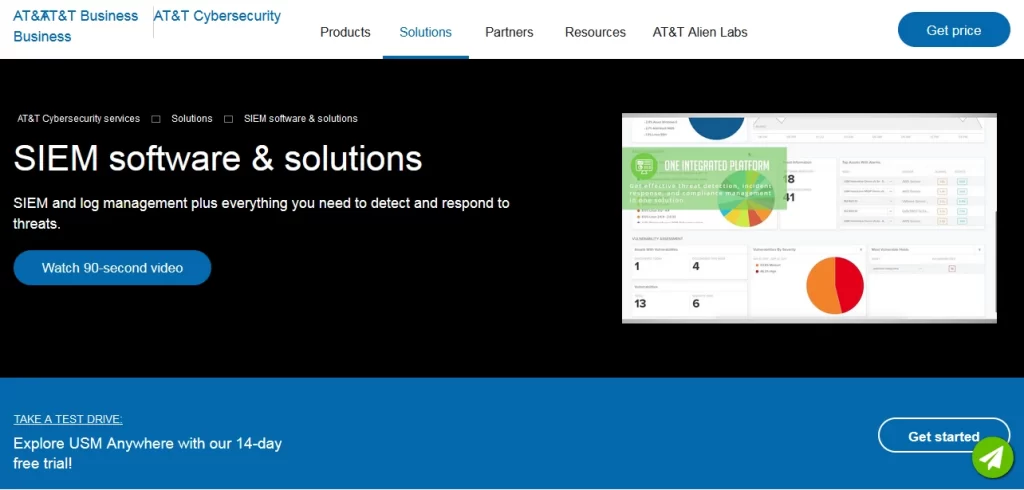
2. LogRhythm NextGen SIEM Platform
LogRhythm SIEM combines security analytics, log management, network monitoring and endpoint monitoring services in a unified manner. Moreover, LogRhythm is a good SIEM tool for smaller organizations. And you can integrate it with other security controls and platforms to get better threat detection and response functionalities.
The SIEM solution enables you to centrally collect log data across the entire network environment to gain real-time visibility into activities that may introduce security risks to your organization.
Key Features
- LogRhytm Labs™
- Detection and SmartReponse
- Network Monitoring
- Reveal threats with network data
- Detect advanced threats
- True application identification
- Metadata generation
- Deep packet analytics (DPA)
- Unstructured search
- Full packet capture
- SmartCapture™
- Packet replay
- Alerts and dashboards
- SIEM integration
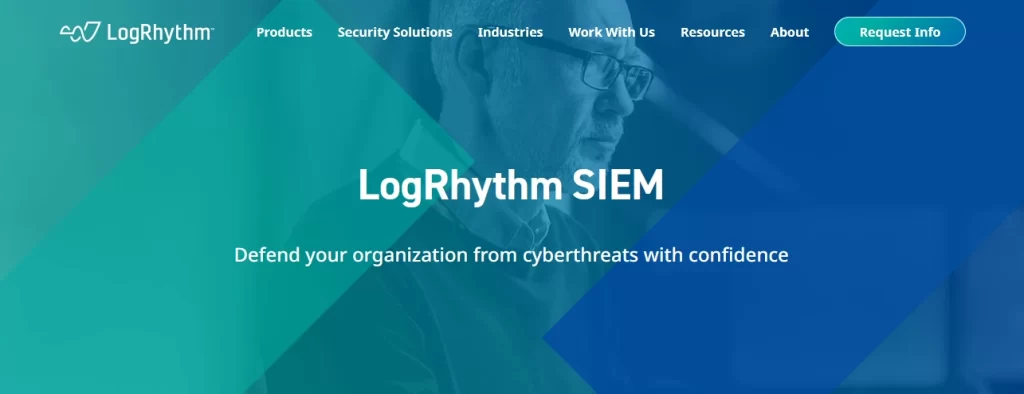
3. IBM Security QRadar SIEM
IBM Security QRadar SIEM provides log and risk management in your organization. And you can deploy it as an appliance, virtual appliance, software as a service (SaaS) or infrastructure as a service (IaaS). Moreover, it offers intelligent security analytics for actionable insight into the most critical threats And it analyzes and correlates activity across multiple data sources including logs, events, vulnerability information and threat intelligence to identify known and unknown threats.
QRadar SIEM correlates and analyzes a variety of data types from threat intelligence, endpoint, network activity, vulnerability, cloud activity, application, and user activity.
Key Features
- Gain complete visibility and control across environments
- Threat management and intelligence
- Master console and activity reports
- User behavior analytics
- Automatic parsing and normalizing of logs
- Intuitive, automatic query builder
- Real-Time Threat Detection
- 700+ integrations
- 1,500+ out-of-the-box use cases aligned to MITRE ATT&CK
- Fully integrated NDR
- Meet compliance requirements such as FISMA, SOX, HIPAA, PCI DSS, GLBA, GDPR, etc.
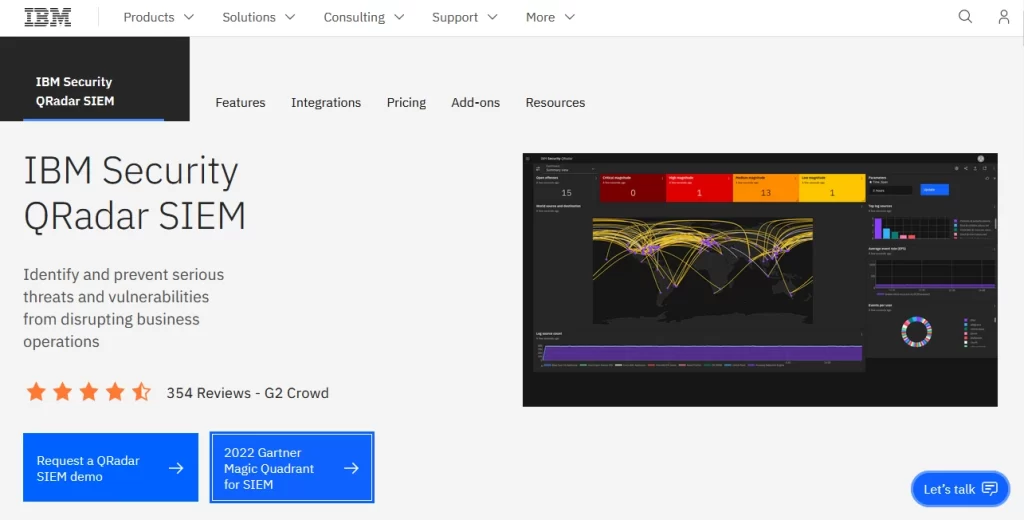
4. Splunk Enterprise SIEM
Splunk is a security solution that you can use to monitor, search, analyze, and visualize log and event data. Furthermore, Splunk Enterprise Security is one of the best SIEM solutions. And it protects your business and modernize your security operations. Additionally, it offers you excellent protection through its data platform, advanced analytics and automated incident investigation and response functionalities.
Splunk Enterprise Security enables you to get data-driven insights, and combat security threat. Moreover, it gives you complete visibility, protect your core businesses, rapid detection and mitigate organizational security risks. And it helps you defend security threats with advanced security analytics, machine learning and threat intelligence.
Key Features
- Fraud analytics and detection
- Incident investigation and forensics
- Security monitoring
- Advanced threat detection
- Security Operation Center (SOC) Automation
- Incident response and management
- Insider threat detection
- Compliance requirements reporting
- Incident review and classification
- Security analytics, correlation and response
- Efficient investigations
- Out-of-the-box security and compliance reporting compliance
- Inbuilt threat intelligence services
- security context with robust integrations capabilities
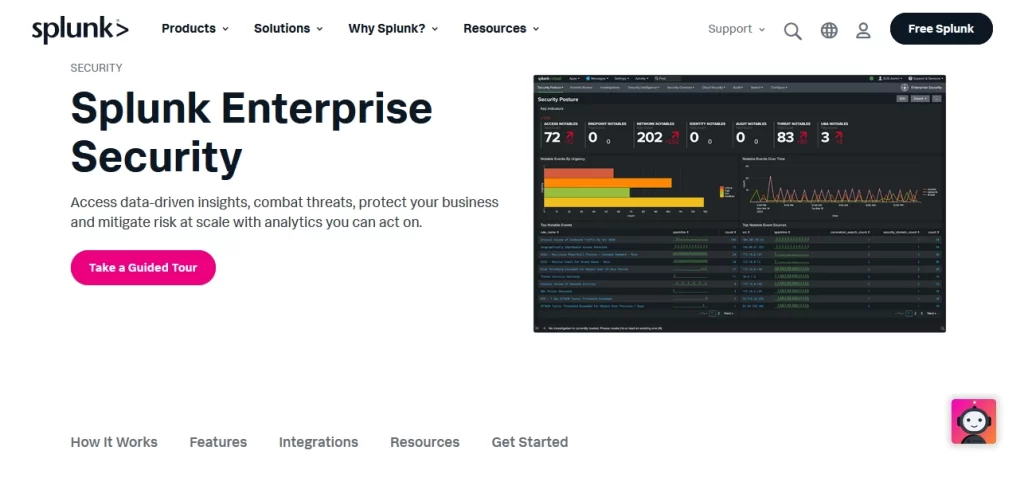
5. ManageEngine Log360 SIEM
Log360 is a SIEM solution that helps you meet your auditing, compliance and security requirements. And it detects and mitigates both internal and external security threats based on its 1200+ predefined reports, 900 alert profiles and 70+ correlation engines and rules. And its Active Directory (AD) auditing functionality helps administrators to closely monitor privileged accounts activities and other behavior analytics to detect anomalies.
ManageEngine Log360 supports 700+ log and event data sources such as switches, servers, routers, IDS/IPS firewalls, database and web servers. Furthermore, it collects, analyzes, correlate and store log and event data from these sources and others to ensure data security in your organization 24/7.
Key Features
- EventLog analyzer
- File integrity monitoring (FIM)
- Log analysis and dashboards
- Detect and respond to security threats faster
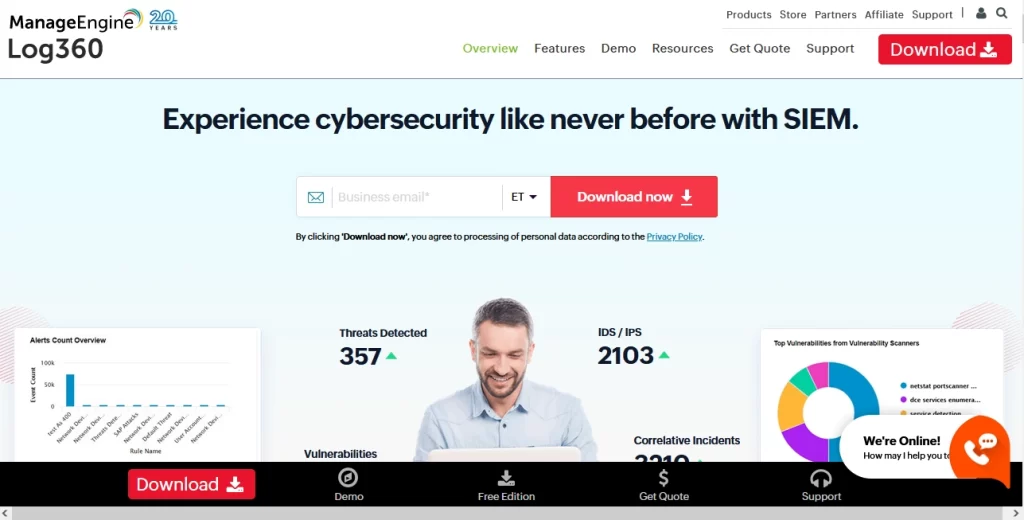
6. Sumo Logic Cloud SIEM Enterprise
Sumo is a cloud SIEM and you can get it in a Software as a Service (SaaS) solution. This means, customers acquire license for the product through-subscription based. Moreover, Sumo Cloud SIEM enables you to investigate incidents by automatically triaging security alerts and correlating security threats across your entire cloud environments.
Sumo Logic Cloud SIEM Enterprise is one of the best security solutions to deliver SOC analytics, and automation to your hybrid and multi-cloud architectures. Furthermore, Cloud SIEM Enterprise is a cloud-native SOC solution that automatically analyzes and correlates security threat alert data. In addition, this in turn helps SOC analysts to efficiently discover and resolve security threats. And it automates the manual work of security analysts thereby saving them time and effort and let them focus on higher-value security functions.
Key Features
- Collects and centralizes logs
- Provides actionable intelligence and advanced insights
- Search and analysis features
- Alert and notification services
- Offers you enhanced visibility and control over your on-premise, cloud, multi-cloud and hybrid cloud data sources.
- Intuitive collaboration
- Threat hunting and response as a service
- Helps you to modernize your cloud security operations
- Deliver improved productivity in your organization
- Unlimited horizontal and vertical scalability
- Focused workflows to reduce risk, perform threat hunting, incident response and remediation activities

7. Exabeam Fusion SIEM
Exabeam Fusion is a modern SIEM solution that provides scalable security operations, log management and powerful behavioral analytics. Furthermore, it offers you automated security threat detection, incident investigation and response functionalities.
Key Features
- Security alert and case management
- Advanced analytics features
- Compromised credentials detection
- Threat intelligence service
- Dynamic security alert prioritization
- Pre-built correlation rules
- Coverage of MITRE ATT&CK
- Context enrichment and awareness
- Monitoring of service health and consumption
- Intuitive reporting functions and dashboards
- Log data collectors and log stream services
- Incident Response and outcomes navigation features
- Provides Common Information Model (CIM) to simplify normalization, categorization, and transformation of raw log data into actionable events
- Simplified and rapid intelligent search experience
- Automated investigation and response functionalities
- Centralized and highly scalable data storage services

8. Microsoft Sentinel
Microsoft Sentinel is a scalable and cloud-native solution that provides SIEM and SOAR functionalities to your environment. And it delivers intelligent security operations, analytics, and threat intelligence services across your enterprise. Moreover, it provides cyberattack detection, security threat visibility proactive threat hunting and response.
Microsoft Sentinel offers next-generation security operations through its cloud-native and artificial intelligence (AI) features.
Key Features
- Collect security data across your entire enterprise
- Detect security threats through threat intelligence services
- Investigate critical incidents through AI
- Respond to security incidents rapidly and automate protection
- Collect data through log and event data connectors
- Correlate security alerts into security incidents through advanced analytics rules
- Hunt for security threats by using built-in queries
- Collect log data at cloud scale—across all users, devices, applications, and infrastructure, both on-premises and in multiple clouds
- Detect previously uncovered security threats and minimize false positives
- Investigate the scope and root cause of security threats
- Respond to incidents rapidly with built-in orchestration and automation of common tasks
- Enhance your threat hunting with notebooks
- Automate and orchestrate common tasks by using playbooks
- Create interactive reports by using workbooks
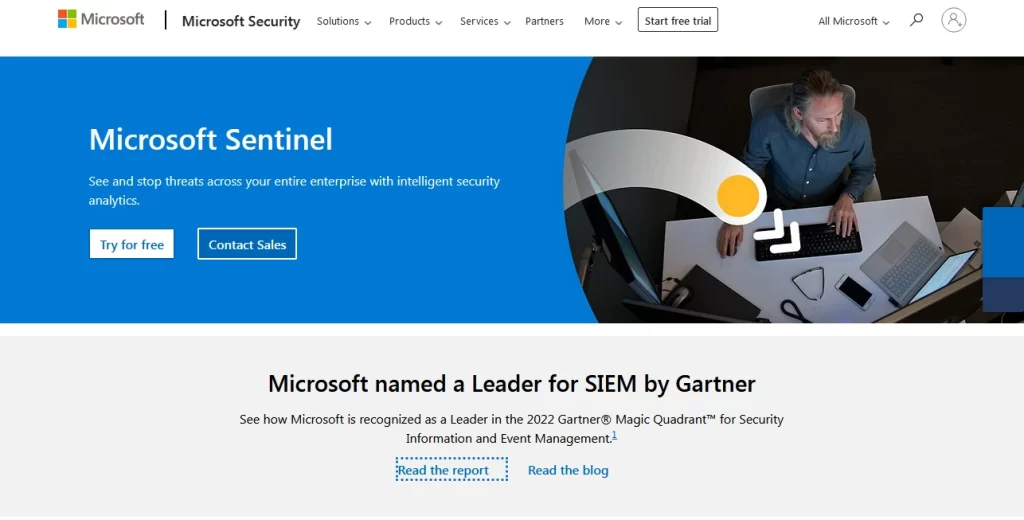
9. Fortinet FortiSIEM
FortiSIEM by Fortinet is unified security event correlation and risk management for modern networks. And it uses machine learning (ML) and user and entity behavior analytics (UEBA) to detect unusual activities in your enterprise. Moreover, it delivers next-generation SIEM capabilities to information security arsenals.
FortiSIEM solution provides visibility, correlation, automated response, and security incident remediation in single and scalable service. Furthermore, it reduces the complexity of managing security operations and networks to effectively utilize resources, enhance security breach detection and prevention.
Key Features
- Scalable and flexible log collection
- Real-time operational context for rapid security analytics
- Unified Network Operation Center (NOC) and SOC analytics
- Advanced multifactor authentication (MFA)
- Automated identity lifecycle control
- User and device risk scoring
- External threat intelligence integration services
- Flexible and fast custom log parsing or normalizing framework
- Distributed real-time event correlation
- Business services dashboard transforms system to service views
- Dynamic user identity mapping
- Automated incident mitigation
- Infusion of security intelligence
- Performance and availability monitoring
- Large enterprise and managed service provider (MS) ready that supports multitenant architecture
- Out-of-the-box compliance reports
- Performance monitoring
- User and entity behavior analytics (UEBA)
- Real-time configuration change monitoring
- Baselining and statistical anomaly detection
- External technology integrations through Application Programming Interface (API)
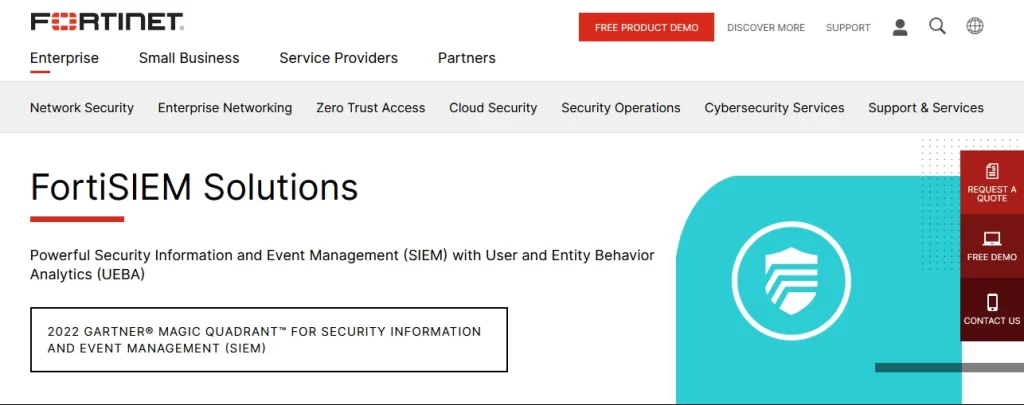
10. Rapid7 InsightIDR
Rapid7 InsightIDR platform is a cloud SIEM solution for modern security threat detection and response. And it collect diverse log and event data across various sources, and scales with your business requirements. Moreover, it enables you to analyze the most complex data and find insights faster. Because, it employs native-cloud data lake, diverse log collection functionalities, custom log normalization, and flexible search and reporting.
InsightIDR empowers security analysts to search huge log volumes, and write convoluted queries. Besides, it highlights security risks across your organization and prioritizes where to search.
Key Features
- Enhanced endpoint visibility
- User behavior analytics
- Centralized log management
- Visual investigation timeline
- Investigate and shut down cyberattacks
- visibility, analytics, and automation
- Monitoring of malicious behavior
- Earlier incident detection in the attack chain
- File integrity monitoring
- Attacker behavior analytics
- Easy deployment and cloud-native data lake
- Eliminate security and compliance silos
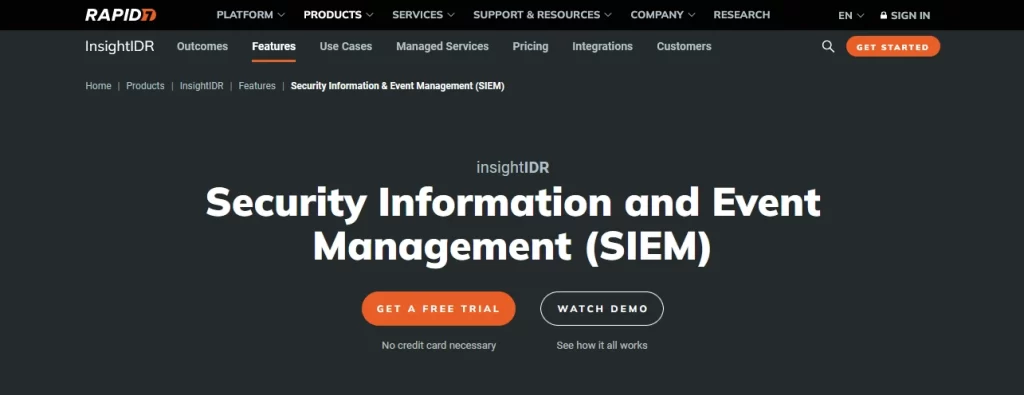
11. Securonix Next-Gen SIEM
Securonix Next-Generation SIEM combines log management, user and entity behavior analytics (UEBA), and security incident response into a complete, end-to-end security operations platform. In addition, it collects massive volumes of data in real-time. And it uses patented machine learning algorithms to detect advanced security threats. Furthermore, it provides artificial intelligence-based security incident response for fast remediation procedures.
Securonix SIEM is cloud native platform and supports big data infrastructure services.
Key Features
- Threat intelligence services
- Cloud security analytics
- Insider threat management
- Collect log and security event data at scale
- Detect unknown security threats
- Easy and flexible deployment options across your enterprise
- Advanced security threats detection
- Simplified and efficient security operations
- Responding to security threats rapidly
- Inbuilt cloud integration capabilities

12. Micro Focus ArcSight Enterprise Security Manager (ESM)
ArcSight ESM is a SIEM tool that provides scalable log and event collection, native security threat intelligence, correlation engine and native SOAR services. And it delivers real-time security threat detection and response in your enterprise.
Key Features
- Ream-time security threat detection and protection
- Simplified compliance
- Managed risk
- Enterprise-wide security event visibility
- Detect security threats in real-time with operational efficiency
- Automate response with native SOAR
- Powerful real-time correlation
- Intelligent and dynamic event risk scoring and prioritization
- Workflows automation
- Categorization and normalization
- ArcSight fusion dashboards
- Active directory integration
- MITRE ATT&CK dashboards
- Schedule reports
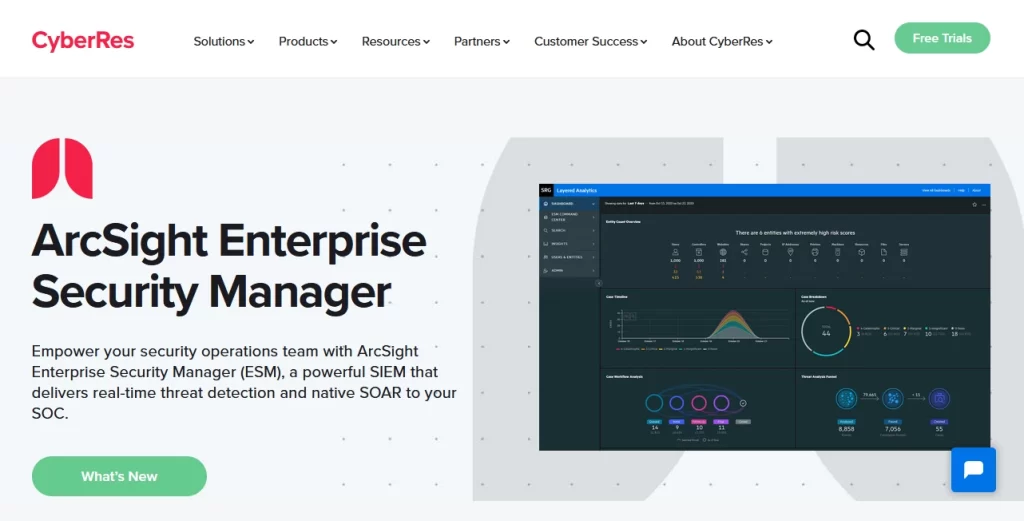
13. Logsign SIEM
Logpoint SIEM empowers security analysts with automation, orchestration and response. And it automatically gathers supporting information for each case to help analysts resolve incidents quickly.
Key Features
- Rapid deployment and easy configuration
- Collects log from environments with multiple, flexible pricing options
- Comprehensive correlation of all your log and event data
- Mitigation and eradication of security threats
- Detection of complicated security threats
- Unlimited log collection and storage services
- Advanced log and event parsing and indexing services
- Accelerated, detailed incident response and investigation
- Automated incident notification, response, and remediation
- Comprehensive correlation of log and event data
- Massively parallelized and fault tolerant solution
- Early detection of cybersecurity threats
- Reduced response times and excluding alert fatigue
- Long term data retention functionality
- Easy to work with normalized, classified and enriched data
- Discover anomalies and indicators of compromise (IoCs) using the MITRE ATT&CK framework
- Prevention of phishing and suspicious network traffic
- Big data infrastructure based on Hadoop & NoSQL platforms
